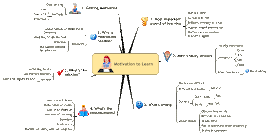| Structuring the Course to Motivate Students |
Work from students' strengths and interests. Find out why students are enrolled in your course, how they feel about the subject matter, and what their expectations are. Then try to devise examples, case studies, or assignments that relate the course content to students' interests and experiences. For instance, a chemistry professor might devote some lecture time to examining the contributions of chemistry to resolving environmental problems. Explain how the content and objectives of your course will help students achieve their educational, professional, or personal goals. (Sources: Brock, 1976; Cashin, 1979; Lucas, 1990) When possible, let students have some say in choosing what will be studied. Give students options on term papers or other assignments (but not on tests). Let students decide between two locations for the field trip, or have them select which topics to explore in greater depth. If possible, include optional or alternative units in the course. (Sources: Ames and Ames, 1990; Cashin, 1979; Forsyth and McMillan, 1991; Lowman, 1984) Increase the difficulty of the material as the semester progresses. Give students opportunities to succeed at the beginning of the semester. Once students feel they can succeed, you can gradually increase the difficulty level. If assignments and exams include easier and harder questions, every student will have a chance to experience success as well as challenge. (Source: Cashin, 1979) Vary your teaching methods. Variety reawakens students' involvement in the course and their motivation. Break the routine by incorporating a variety of teaching activities and methods in your course: role playing, debates, brainstorming, discussion, demonstrations, case studies, audiovisual presentations, guest speakers, or small group work. (Source: Forsyth and McMillan, 1991) |
| De-emphasizing Grades |
Emphasize mastery and learning rather than grades. Ames and Ames (1990) report on two secondary school math teachers. One teacher graded every homework assignment and counted homework as 30 percent of a student's final grade. The second teacher told students to spend a fixed amount of time on their homework (thirty minutes a night) and to bring questions to class about problems they could not complete. This teacher graded homework as satisfactory or unsatisfactory, gave students the opportunity to redo their assignments, and counted homework as 10 percent of the final grade. Although homework was a smaller part of the course grade, this second teacher was more successful in motivating students to turn in their homework. In the first class, some students gave up rather than risk low evaluations of their abilities. In the second class, students were not risking their self-worth each time they did their homework but rather were attempting to learn. Mistakes were viewed as acceptable and something to learn from. Researchers recommend de-emphasizing grading by eliminating complex systems of credit points; they also advise against trying to use grades to control nonacademic behavior (for example, lowering grades for missed classes) (Forsyth and McMillan, 1991; Lowman 1990). Instead, assign ungraded written work, stress the personal satisfaction of doing assignments, and help students measure their progress. Design tests that encourage the kind of learning you want students to achieve. Many students will learn whatever is necessary to get the grades they desire. If you base your tests on memorizing details, students will focus on memorizing facts. If your tests stress the synthesis and evaluation of information, students will be motivated to practice those skills when they study. (Source: McKeachie, 1986) Avoid using grades as threats. As McKeachie (1986) points out, the threat of low grades may prompt some students to work hard, but other students may resort to academic dishonesty, excuses for late work, and other counterproductive behavior. |
Jumat, 02 Mei 2008
How teacher motivated student
Langganan:
Posting Komentar (Atom)




Tidak ada komentar:
Posting Komentar